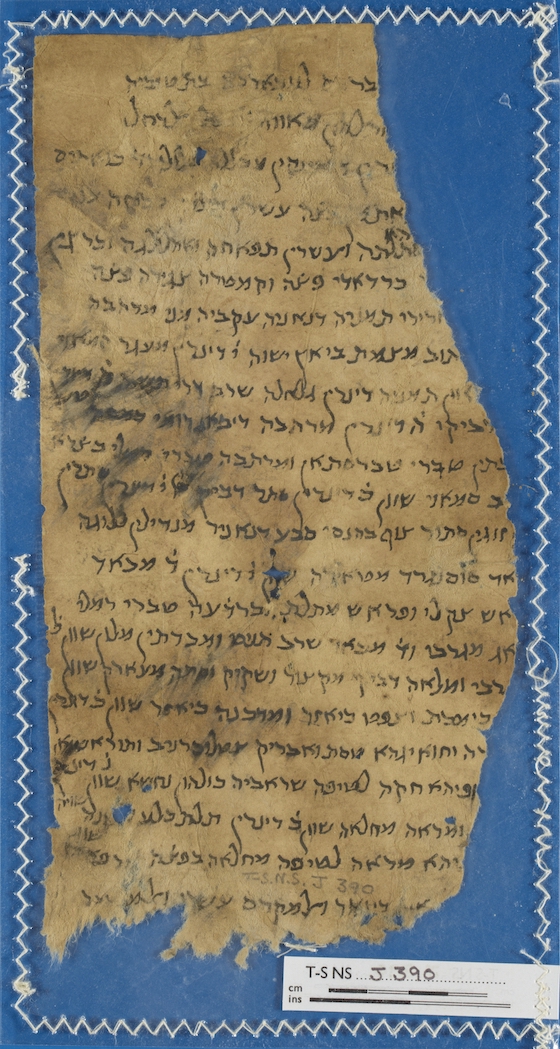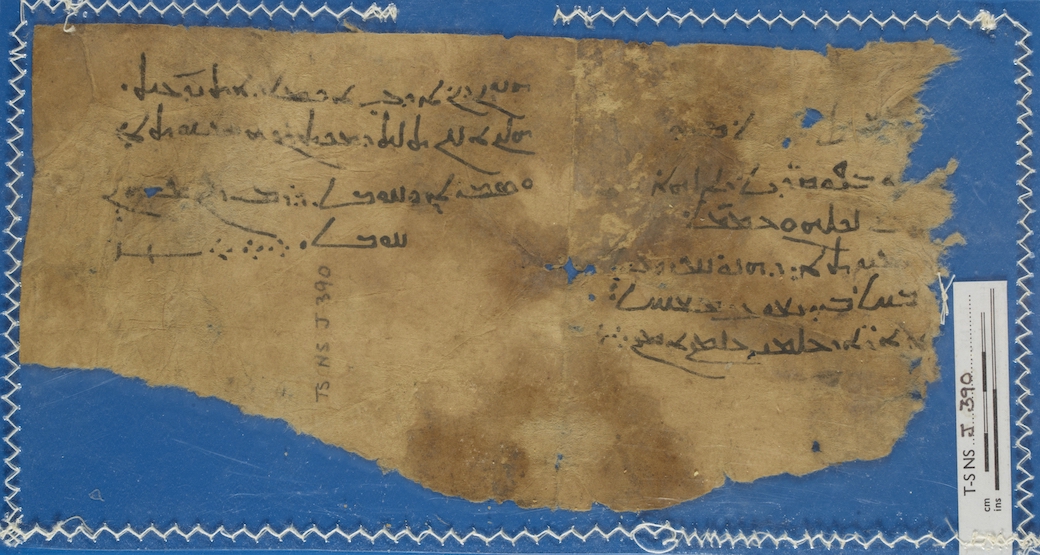Throwback Thursday: Trousseau list tells only half a story

Our Throwback Thursday this week is taken from issue 41 of the printed edition of Genizah Fragments, published in April 2001, by Erica C.D. Hunter and Friedrich Niessen:
In 1980, in the fourth volume of A Mediterranean Society, page 467, S. D. Goitein noted that T-S NS J390 (23.5 x 11.7 cms) and T-S 13J7.8 (27.4 x 6.5 cms) could be conjoined to form a Judaeo-Arabic trousseau list. He did not, however, mention that on the reverse were several verses, written in Syriac, from the Pauline Epistles.
The trousseau list of twenty-four lines would have been attached to the marriage contract and itemizes the dowry that the bride, Mubaraka daughter of Tobias, brought to the house of her husband. These items remained her property.
Her husband, Yeshu‘ah son of Abraham, had to declare in the presence of elders “that all these valuables had come into his house and were now in his possession and under his hand; and that he had undertaken to keep them as if they were his own; and that he would not make any change to them without the knowledge and consent of his wife.”; (See Goitein in AJS Review 2, 1977, page 85.)
In pre-nuptial contracts such as these, the full value of the dowry was to be returned to the bride should she be widowed or divorced. Not unnaturally, a bride would strive to have as expensive a dowry as possible, since this was her insurance policy should there be troubled times.
The total value of Mubaraka’s trousseau list, given at the end of the document, is 480 dinars. This is not a huge amount, since wealthy dowries could be several thousand dinars, but it is enough to place her comfortably in the middle classes of the Jewish community.
The inventory of items - jewellery, clothing, furniture and utensils - provides a fascinating insight into Mubaraka’s life and even allows us to visualize her appearance.
One of her garments, a long greyish robe, interwoven with gold thread, that reached her heels, was offset by a pearl-white turban, with the ends hanging down her back.
Her matrimonial home was furnished with divans (often covered in expensive, imported fabrics) and storage chests, and she had a trunk made of bamboo.
The dowry also mentions a container for soda ashes that were used for washing the body.
Some of the goods came from distant places. Mubaraka would have been justly proud to wear the chain of “twenty-three amber beads in the shape of apples and cherry-plums, that was divided by nine gold beads.”; Amber came from the Baltic regions, and was brought to the Middle East by Viking traders down the Volga river.
Two of her divans were covered in a sumptuous heavy shot silk, originally manufactured in Tabaristan near the Caspian Sea in Persia. Closer to home, another divan was covered in brocade of Italian origin and there were cushions of Sicilian silk, as well as divider curtains of Tunisian brocade.
The trousseau list allows an exciting glimpse into middle-class life of the Jewish community in Fustat during the eleventh century, showing a society with goods from diverse sources and highlighting the international trade links. Yet the trousseau list might have been only a draft, for it was written on the back of an earlier document with very different origins.
T-S NS J390 recto consists of verses from the Peshitta version of the Pauline Epistles in a distinctive western Syriac hand. This fragment must have originated in one of the Monophysite (Syrian Orthodox) or Melkite communities that lived in Egypt.
The Christian scribe did not take especial care when writing the quotations, for the lines are not ruled and their spacing varies, being done “by eye”;. The central crease, which can still be seen, shows that T-S NS J390r was originally folded.
It is possible that the quotations from Romans 16:26-27 and I Corinthians 13:12-13 were merely selections, to highlight particular qualities, such as “faith, hope and love”; (verse 13). More probably, T-S NS J390r was originally part of a codex, since the verses conclude their respective books. Presumably the intermediate folios of I Corinthians 1 - 12:11 were lost.
The circumstances in which this folio was recycled to record Mubaraka’s trousseau list are perplexing. Perhaps the scribe bought the codex, or perhaps only some leaves, second-hand.
The extra spacing between lines 13-14 shows that he took care not to write on the crease where the folio was originally folded. Presumably the copyist, as well as Mubaraka and Yeshu‘ah, could not read Romans 16:27, which cites the name of Jesus Christ. Nor did it seem to matter that the pre-nuptial contract had writing on its reverse.
The contents of T-S NS J390r and T-S NS J390v - T-S 13J7.8 are diverse and unrelated. However, their mutual presence is testimony not only to the richness of life in medieval Fustat, but to the Christian and Jewish communities that lived there during the Fatimid period. We hope soon to publish them fully.

What happened next? Our dear colleague, Friedrich, passed away in January 2009, but his research on the Syriac verses found on these fragments was published posthumously in his article ‘New Testament translations from the Cairo Genizah’, Collectanea Christiana Orientalia 6 (2009), pp. 201-222.

Comments
Niessen posthumous work
And, just to point out, that Friedrich Niessen's posthumous work, 'An Anonymous Karaite Commentary on Hosea from the Cairo Genizah', is currently in press and should be out later this year, thanks to the efforts of Geoffrey Khan.
Add new comment